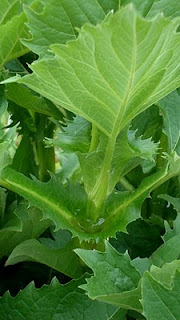All three develop deep tap roots, the ability to endure rough weather, bright sunflower like yellow blooms, great structural form in winter and a definite desire to attract wildlife of the flying kind in all seasons.
Large, strong plants with a controversial past, one is considered invasive in New England, another made the endangered list in Michigan, the third is known for medicinal properties – all three silphiums enchant my place and will, I hope, choose to stay. Or as I like to think of them, the plants for the future of gardens,reminders of the great prairie spaces inhabited by buffalo in the Midwest, of ancient days when ferns were trees, and clubfoot pine grew to heights unimagined.
Cup plant (Silphium perfoliatum)
A water needy plant, yet it grows well in my yard, it multiplies (happily, it invades) with our disturbing and alternate regime of drought and flood. I do set the hose and water it for ten minutes, when things get truly bad. Tiger swallowtails, black swallowtails, monarchs, cabbage white, skippers and a myriad of bees and wasps play and feed with the mineral water sweet nectar food of the flowers.
Silphium perfoliatum quenches the thirst of an infinite number of insects. While photographing butterflies, I am always careful of the wasps and spiders hovering and crawling about. The common name refers to the intersection of the square stem and rounded leaves, where a virtual drinking vessel is formed. (Photo above)
I do not collect seeds because the plants self seed and spread. In my garden this is desirable and I enjoy the tall showy mass of yellows in flower. It is threatened in Michigan and considered invasive in Connecticut.
Prairie Dock (Silphium terebinthinaceum)
The second Silphium is Prairie Dock. Silphium terenbithinaceum, or the one that contains turpentine. It sends roots down deep and survives harsh drought conditions. Rough leaves spread out in a rosette and strong stalks reach up for the sky in multiple yellow blooms. This year it is starting to bloom only now, later than in other years. I fotographed the flowers for the first time and have not seen butterflies there yet.
Compass Plant (Silphium laciniatum)
Then we come to the forgotten one, the endangered one – the Compass plant. Described in the literature as a guiding companion to explorers, it blooms in July and August here. Favorite perch for goldfinches in the fall, when seeds are ready and plentiful.
When young it reminds me of the tropical Monsteras deliciosas of my teen years, house plants in the Northern Hemisphere, but wilderness statements in the South.
The Compass Plant sends strong shoots up into the blue sky and it blooms, like sunflowers tend to bloom. The stalks are so heavy they eventually fall. I leave them on the ground and have seen early spring birds feeding on the seeds.
In a recent article in the Missouri Conservationist, Carol Davit explains how the basal leaves arrange themselves in a North South direction so as to maximize exposure to the morning sun and conserve energy during the heat of the day.
The Compass plant is my wild companion, it dies in winter and I wonder every year if it will come back to grace my territory. So far, for some twelve years, it has. This year I will try to propagate it by seed.













Nenhum comentário:
Postar um comentário